Table of Contents
Coterminal Angle Calculator is an online tool that displays both positive and negative coterminal angles for a given degree value. STUDYQUERIES’s online coterminal angle calculator tool makes the calculation faster and displays the coterminal angles in a fraction of a second.
How to Use the Coterminal Angle Calculator?
To use the coterminal angle calculator, follow these steps:
- Step 1: Enter the angle in the input box
- Step 2: To find out the coterminal angle, click the button “Calculate Coterminal Angle”
- Step 3: The positive and negative coterminal angles will be displayed in the output field
Coterminal Angle Calculator
What Are Coterminal Angles?
Angles that have the same initial side and share their terminal sides are coterminal angles. Although their values are different, the coterminal angles occupy the standard position. They are located in the same quadrant, have the same sides, and have the same vertices. When the angles are rotated clockwise or anticlockwise, the terminal sides coincide at the same angle. As a measure of rotation, an angle is the angle of rotation of a ray about its origin.
The initial side refers to the original ray, and the final side refers to the position of the ray after its rotation.
Think about 45°. Since its terminal side is also located in the first quadrant, it has a standard position in the first quadrant. Take a look at the image.
Coterminal Angles
- After full rotation anticlockwise, 45° reaches its terminal side again at 405°. In the first quadrant, 405° coincides with 45°.
- After a full rotation clockwise, 45° reaches its terminal side again at -315°. This corresponds to 45° in the first quadrant.
Thus 405° and -315° are coterminal angles of 45°.
What is the Formula of Coterminal Angles?
The formula to find the coterminal angles of an angle θ depending upon whether it is in terms of degrees or radians is:
$$Degrees =\Theta \pm 360° n$$
$$Radians =\Theta \pm 2\pi n$$
In the above formula, θ ± 360n, 360n denotes a multiple of 360, since n is an integer and it refers to rotations around a plane.
We can therefore conclude that 45°, -315°, 405°, – 675°, 765°,… all form coterminal angles. The only difference is the number of complete circles. Two angles are said to be coterminal if the difference between them is a multiple of 360° (or 2π, if the angle is in radians). To understand the concept, let’s look at an example.
Find two coterminal angles of 30°.
Solution: The given angle is, $$\Theta = 30° $$
The formula to find the coterminal angles is, $$\Theta \pm 360° n $$
Let us find the first and the second coterminal angles.
Finding First Coterminal Angle: n = 1 (anticlockwise)
Then the corresponding coterminal angle is,
$$=\Theta +360° n $$
$$=30° +360° \left(1 \right)$$
$$=390° $$
Finding Second Coterminal Angle : n = −2 (clockwise)
Then the corresponding coterminal angle is,
$$=\Theta +360° n $$
$$=30° +360° \left(-2 \right) $$
$$=-690° $$
How to Find Coterminal Angles?
We can determine the coterminal angle(s) of any angle by adding or subtracting multiples of 360° (or 2π) from the given angle. Therefore, we do not need to use the coterminal angles formula to calculate the coterminal angles.
The coterminal angles of any given angle can be found by adding or subtracting 360° (or 2π) multiples of the angle. We will illustrate this concept with the help of an example.
Example: Find a coterminal angle of $$\frac{\pi }{4}$$
Solution: The given angle is $$\Theta = \frac{\pi }{4}$$, which is in radians. So we add or subtract multiples of 2π from it to find its coterminal angles.
Let us subtract 2π from the given angle.
$$\frac{\pi }{4} − 2\pi = \frac{-7\pi }{4}$$
Thus, The coterminal angle of $$\frac{\pi }{4}\ is\ \frac{-7\pi }{4}$$
What are Positive and Negative Coterminal Angles?
The coterminal angles can be positive or negative. In one of the above examples, we found that 390° and -690° are the coterminal angles of 30°
Here,
- 390° is the positive coterminal angle of 30° and
- -690° is the negative coterminal angle of 30°
$$\Theta \pm 360° n$$, where n takes a positive value when the rotation is anticlockwise and takes a negative value when the rotation is clockwise.
So we decide whether to add or subtract multiples of 360° (or 2π) to get positive or negative coterminal angles respectively.
Coterminal Angles and Reference Angles
We already know how to find the coterminal angles of an angle.
Any angle has a reference angle between 0° and 90°, which is the angle between the terminal side and the x-axis. This angle varies depending on the quadrant’s terminal side.
The steps for finding the reference angle of an angle depending on the quadrant of the terminal side:
- As a first step, we determine its coterminal angle, which lies between 0° and 360°.
- Next, we see the quadrant of the coterminal angle.
- Whenever the terminal side is in the first quadrant (0° to 90°), the reference angle is the same as our given angle. A given angle of 25°, for instance, will also have a reference angle of 25°.
- If the terminal side is in the second quadrant (90° to 180°), the reference angle is (180° – given angle). As an example, if the angle given is 100°, then its reference angle is 180° – 100° = 80°.
- A terminal side in the third quadrant (180° to 270°) has a reference angle of (given angle – 180°). For example, if the angle is 215°, then the reference angle is 215° – 180° = 35°.
- The reference angle if the terminal side is in the fourth quadrant (270° to 360°) is (360° – given angle). An angle of 330°, for example, can be referred to as 360° – 330° = 30°.
Example for Finding Coterminal Angles and Classifying by Quadrant
Assume that the angles given are in standard position. Calculate the measure of the positive angle with a measure less than 360° that is coterminal with the given angle. Classify the angle by quadrant.
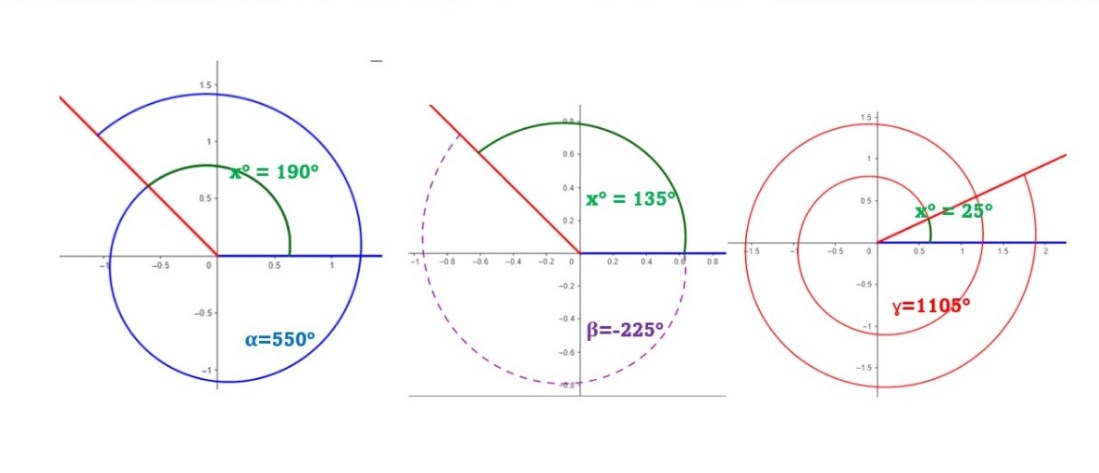
$$\alpha = 550°, \beta = -225° , \gamma = 1105° $$
Solution: Start the solution by writing the formula for coterminal angles. Let $$\angle \theta = \angle \alpha = \angle \beta = \angle \gamma$$
Solve for the angle measure of x° for each of the given angles in standard position. The resulting solution, ∠ɑ, is a Quadrant III angle while the ∠β is a Quadrant II angle.
$$\angle \theta = x° + 360°n$$
$$\angle \alpha = x° + 360° \left(1 \right)$$
$$550° = x° + 360°$$
$$x° = 550° – 360°$$
$$x° = 190°$$
So,
$$\angle \theta = x° + 360°n$$
$$\angle \beta = x° + 360°n$$
$$-225° = x° + 360° \left(-1 \right)$$
$$x° = -225° + 360°$$
$$x° = 135°$$
Since $$\angle \gamma = 1105°$$ exceeds the single rotation in a cartesian plane, we must know the standard position angle measure. The solution below, ∠ɣ, is an angle formed by three complete counterclockwise rotations, plus 5/72 of a rotation. In converting 5/72 of a rotation to degrees, multiply 5/72 with 360°.
Therefore, incorporating the results to the general formula:
$$\angle \theta = x° + 360°n$$
$$\angle \gamma = x° + 360°n$$
$$1105° = x° + 360°\left(3 \right)$$
$$x° = 1105° – 1080°$$
$$x° = 25°$$
Therefore, the positive coterminal angles (less than 360°) of
$$\alpha = 550° \, \beta = -225°\, \gamma = 1105°\ is\ 190°\, 135°\, and\ 25°\, respectively.$$
Example For Finding Coterminal Angles For Smallest Positive Measure
Find the angle of the smallest positive measure that is coterminal with each of the following angles.
$$820°, -520°$$
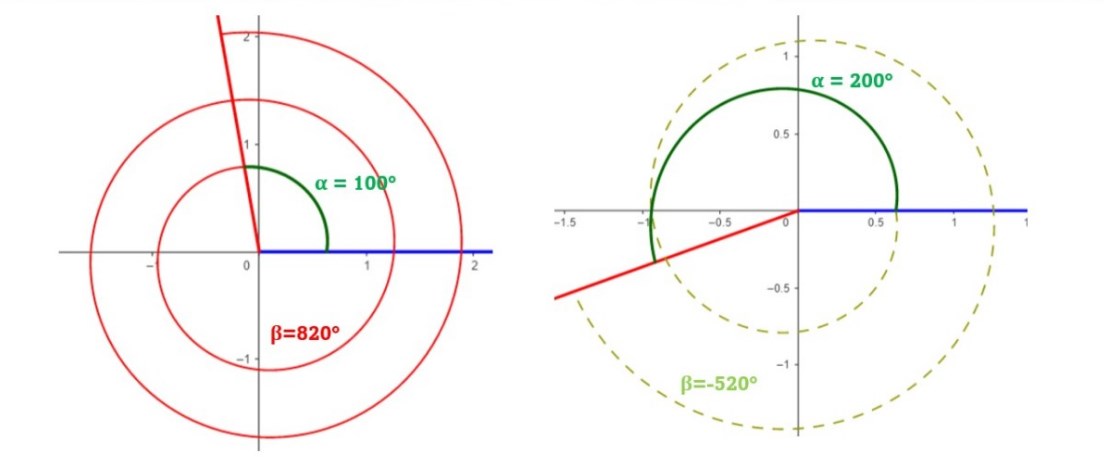
The given angle measure in letter a is positive. Since it is a positive angle and greater than 360°, subtract 360° repeatedly until one obtains the smallest positive measure that is coterminal with measure 820°.
$$820° – 360° = 460°$$
$$460° – 360° = 100°$$
Take note that -520° is a negative coterminal angle. Since the given angle measure is negative or non-positive, add 360° repeatedly until one obtains the smallest positive measure of coterminal with the angle of measure -520°.
$$-520° + 360° = -160°$$
$$-160° + 360° = 200°$$
As a result, the angles with measure 100° and 200° are the angles with the smallest positive measure that are coterminal with the angles of measure 820° and -520°, respectively.
Example For Finding All Coterminal Angles With 120°
For any integer k, $$120° + 360° k$$ will be coterminal with 120°. Shown below are some of the coterminal angles of 120°.
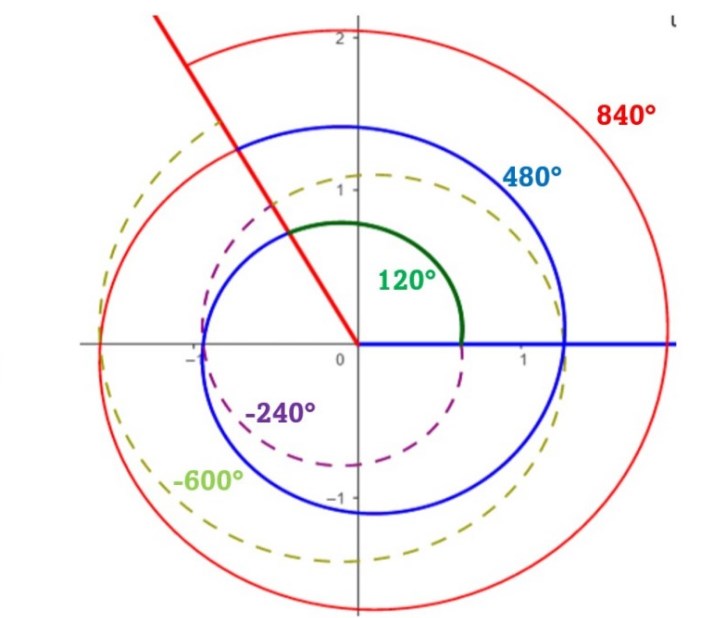
At k = -2
$$\angle \theta = 120° + 360° (-2)$$
$$\angle \theta = 120° – 720°$$
$$\angle \theta = -600°$$
At k = -1
$$\angle \theta = 120° + 360° (-1)$$
$$\angle \theta = 120° – 360°$$
$$\angle \theta = -240°$$
At k = 1,
$$\angle \theta = 120° + 360° (1)$$
$$\angle \theta = 480°$$
At k = 2.
$$\angle \theta = 120° + 360° (2)$$
$$\angle \theta = 120° + 720°$$
$$\angle \theta = 840°$$
Therefore, the formula $$\angle \theta = 120° + 360° k$$ represents the coterminal angles of 120°.
Example For Determining Two Coterminal Angles and Plotting For -90°
Draw – 90° in standard position. Calculate two coterminal angles, two positives, and two negatives, that are coterminal with -90°.
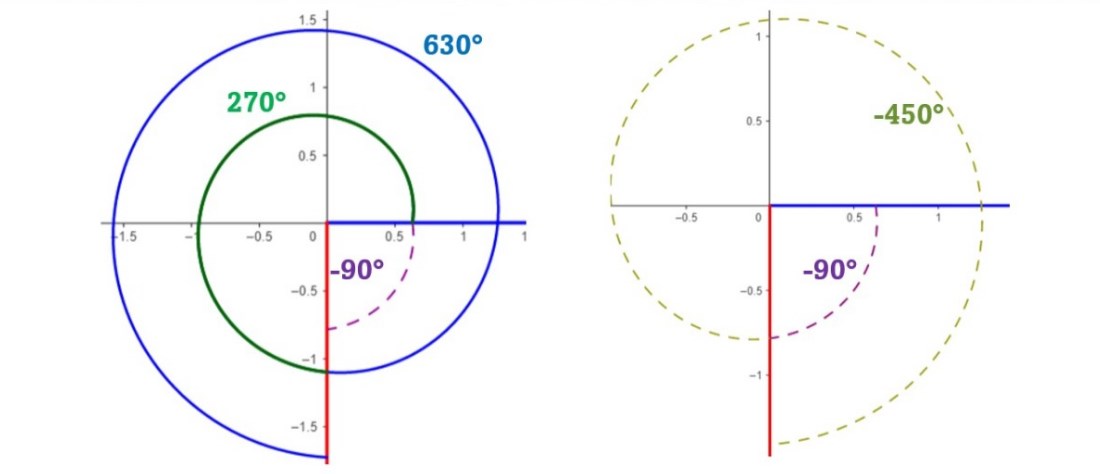
Above is a picture of -90° in standard position. To determine positive and negative coterminal angles, traverse the coordinate system in both positive and negative directions. Let $$x° = -90°$$
At k = 1
$$\angle \theta = x° + 360° (k)$$
$$\angle \theta = -90° + 360° (1)$$
$$\angle \theta = 270°$$
At k = 2
$$\angle \theta = x° + 360° (k)$$
$$\angle \theta = -90° + 360° (2)$$
$$\angle \theta = 630°$$
At k = -1
$$\angle \theta = x° + 360° (k)$$
$$\angle \theta = -90° + 360° (-1)$$
$$\angle \theta = -450°$$
At k = -2
$$\angle \theta = x° + 360° (k)$$
$$\angle \theta = -90° + 360° (-2)$$
$$\angle \theta = -810°$$
Therefore, 270° and 630° are two positive angles coterminal with -90°. On the other hand, -450° and -810° are two negative angles coterminal with -90°.
Coterminal Angle Theorem and Reference Angle Theorem
Find the exact value of cos (495°).
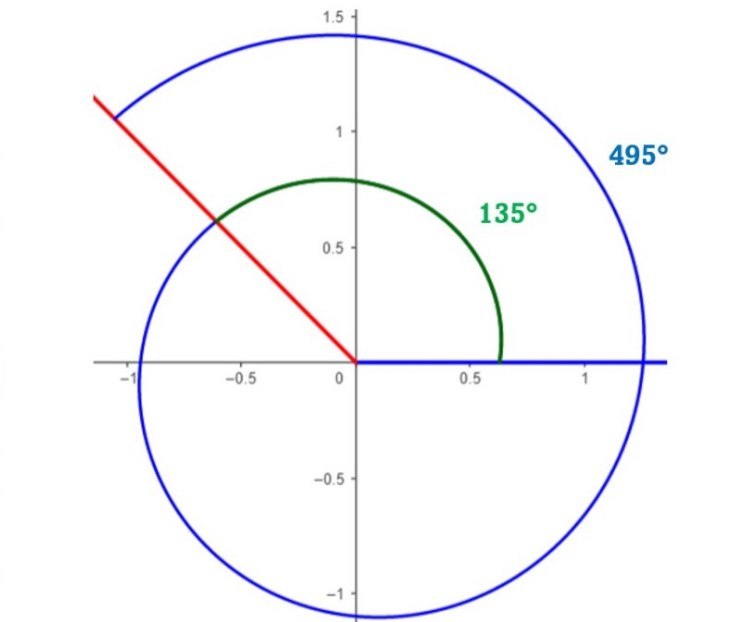
We can determine the coterminal angle by subtracting 360° from the given angle of 495°. Reference angles, or related angles, are positive acute angles between the terminal side of θ and the x-axis for any angle θ in standard position. 135° has a reference angle of 45°. As 495° terminates in quadrant II, its cosine is negative.
$$495° – 360° = 135°$$
$$cos (495°) = cos (135°)$$
$$cos (495°) = – cos (45°)$$
$$cos (495°) = – √2/2$$
The exact value of $$cos (495°)\ is\ – √2/2.$$
Example For Finding Measures of Coterminal Angles
Find the angles that are coterminal with the angles of least positive measure.
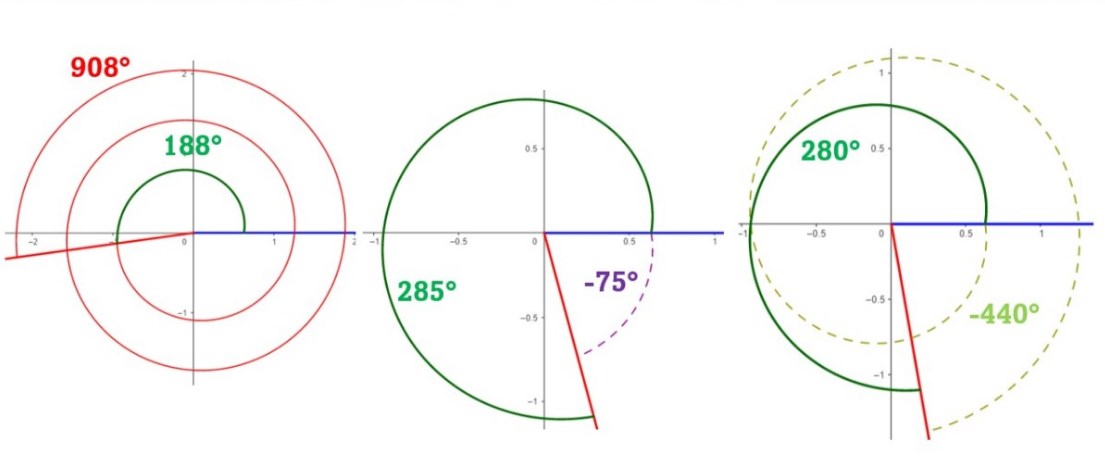
$$908°, -75°, -440°$$
Subtract 360° multiple times to obtain an angle with a measure greater than 0° but less than 360° for the given angle measure of 908°.
$$908° – 360° = 548°$$
$$620° – 360° = 188°$$
For letter b with the given angle measure of -75°, add 360°.
$$-75° + 360° = 285°$$
Lastly, for letter c with an angle measure of -440°, add 360° multiple times to achieve the least positive coterminal angle.
$$-440° + 360° = -80°$$
$$-80° + 360° = 280°$$
Measures of the positive angles coterminal with 908°, -75°, and -440° are respectively 188°, 285°, and 280°.
Example For Finding Coterminal Angles and Reference Angles
Let θ = 928°, then find the following:
- What angle between 0° and 360° has the same terminal side as θ?
- For θ, what is the reference angle?
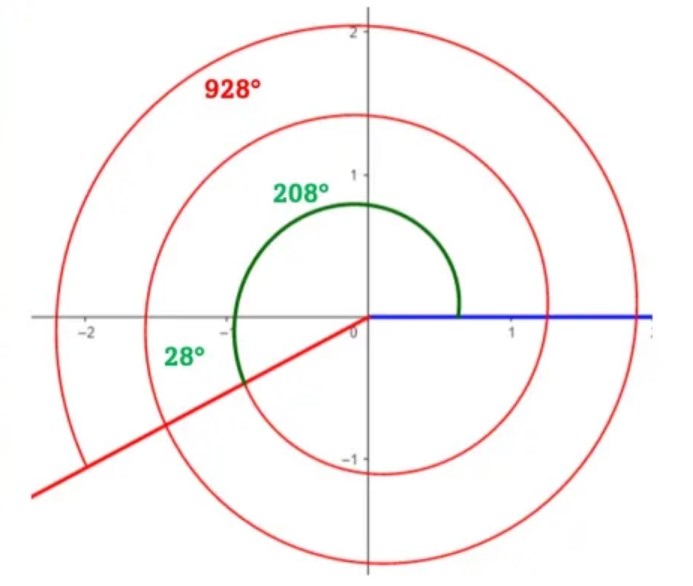
If necessary, add 360° several times to reduce the given θ to the smallest coterminal angle possible between 0° and 360°.
$$928° – 360° = 568°$$
$$568° – 360° = 208°$$
Identify the quadrant in which the coterminal angles are located. Because 928° and 208° have the same terminal side in quadrant III, the reference angle for θ = 928° can be identified by subtracting 180° from the coterminal angle between 0° and 360°.
$$208° – 180° = 28°$$
The angle between 0° and 360° has the same terminal angle as θ = 928°, which is 208°, while the reference angle is 28°.
Example For Finding Coterminal Primary Angles
What is the primary angle coterminal with the angle of -743°?
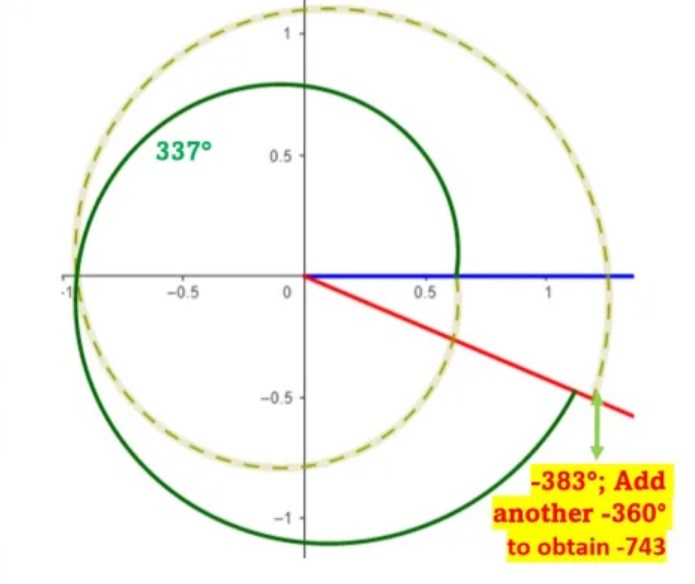
Write the equation using the general formula for coterminal angles: $$\angle \theta = x° + 360°n $$ given that $$ = -743$$
$$ -743° = x° – 360°n$$
$$ -743° = x° – 360°(3)$$
$$ -743° = x° – 1080°$$
The equation is multiplied by -1 on both sides. An angle larger than but closer to the angle of 743° is resulted by choosing a positive integer value for n.
$$-1 (-743°) = -1 (x° – 1080°)$$
$$743° = -x° + 1080°$$
$$x° = 1080° – 743°$$
$$x° = 337°$$
The primary angle coterminal to $$\angle \theta = -743 is x° = 337°$$
Important Points
- Differences between any two coterminal angles (in any order) are multiples of 360°.
- The coterminal angle of an angle can be found by adding or subtracting multiples of 360° from the angle given.
- The number of coterminal angles of an angle is infinite because 360° has an infinite number of multiples.
- When two angles are coterminal, their sines, cosines, and tangents are also equal.
Find an Angle Between 0 and 2π That is Coterminal with Calculator:
Coterminal angles are angles that have the same initial and terminal sides but differ by a multiple of 360 degrees (or 2π radians). To find an angle between 0 and 2π that is coterminal with a given angle, you can simply add or subtract multiples of 360 degrees (or 2π radians) until you get an angle within the desired range.
For example, let’s say the given angle is 450 degrees. To find a coterminal angle between 0 and 2π, you can subtract 360 degrees from 450: 450 – 360 = 90 degrees. So, 90 degrees is a coterminal angle with 450 degrees between 0 and 2π.
Negative Coterminal Angle Calculator:
Negative coterminal angles are angles that are less than 0 and share the same terminal side as a given angle. To calculate a negative coterminal angle, you can subtract multiples of 360 degrees (or 2π radians) from the given angle until you obtain a negative angle.
For example, if the given angle is 720 degrees, you can subtract 360 degrees to find a negative coterminal angle: 720 – 360 = 360 degrees. Therefore, 360 degrees is a negative coterminal angle with 720 degrees.
Radian Coterminal Angle Calculator:
In the case of coterminal angles measured in radians, you can apply a similar approach. To calculate a radian coterminal angle, you can add or subtract multiples of 2π radians until you get a coterminal angle.
For instance, if the given angle is 3π/2 radians, you can add 2π radians to find a coterminal angle: 3π/2 + 2π = 7π/2 radians. Therefore, 7π/2 radians is a coterminal angle with 3π/2 radians.
Positive Coterminal Angle Calculator:
Positive coterminal angles are angles greater than 0 that share the same terminal side as the given angle. To calculate a positive coterminal angle, you can add multiples of 360 degrees (or 2π radians) to the given angle until you obtain a positive angle.
For example, if the given angle is -90 degrees, you can add 360 degrees to find a positive coterminal angle: -90 + 360 = 270 degrees. Hence, 270 degrees is a positive coterminal angle with -90 degrees.
Greatest Negative Coterminal Angle Calculator:
The greatest negative coterminal angle is the largest negative angle that shares the same terminal side as the given angle. To find the greatest negative coterminal angle, you can subtract multiples of 360 degrees (or 2π radians) from the given angle until you reach the largest negative angle.
For instance, if the given angle is 450 degrees, you can subtract 360 degrees repeatedly until you obtain a negative angle: 450 – 360 = 90 degrees, 90 – 360 = -270 degrees. Therefore, -270 degrees is the greatest negative coterminal angle with 450 degrees.
Coterminal Angle Formula:
The coterminal angle formula allows you to find coterminal angles using a mathematical equation. The formula is:
Coterminal angle = Given angle ± (n * 360 degrees) or ± (n * 2π radians),
where n is an integer representing the number of complete revolutions added or subtracted.
Largest Negative Coterminal Angle Calculator:
The largest negative coterminal angle
is the most negative angle that shares the same terminal side as the given angle. To calculate the largest negative coterminal angle, you can subtract multiples of 360 degrees (or 2π radians) from the given angle until you reach the largest negative angle.
For example, if the given angle is 270 degrees, you can subtract 360 degrees until you obtain the largest negative coterminal angle: 270 – 360 = -90 degrees. Thus, -90 degrees is the largest negative coterminal angle with 270 degrees.
Coterminal Angle Calculator with π:
If you want to find coterminal angles using radians and π, you can utilize the same principles as mentioned earlier. Add or subtract multiples of π until you obtain the desired coterminal angle.
For instance, if the given angle is 3π/4 radians, you can add 2π radians to find a coterminal angle with π: 3π/4 + 2π = 11π/4 radians. Therefore, 11π/4 radians is a coterminal angle with 3π/4 radians.
Smallest Positive Coterminal Angle Calculator:
The smallest positive coterminal angle is the smallest positive angle that shares the same terminal side as the given angle. To calculate the smallest positive coterminal angle, you can add multiples of 360 degrees (or 2π radians) to the given angle until you reach the smallest positive angle.
For example, if the given angle is -540 degrees, you can add 360 degrees repeatedly until you obtain a positive angle: -540 + 360 = -180 degrees, -180 + 360 = 180 degrees. Hence, 180 degrees is the smallest positive coterminal angle with -540 degrees.
Coterminal Angle Calculator with Steps:
To calculate coterminal angles with steps, you can follow the coterminal angle formula and perform the necessary calculations in a systematic manner. For each step, add or subtract the appropriate multiple of 360 degrees (or 2π radians) to find the coterminal angle.
For example, if the given angle is 720 degrees, you can calculate the coterminal angle with steps as follows:
Step 1: Subtract 360 degrees: 720 – 360 = 360 degrees
Step 2: Subtract another 360 degrees: 360 – 360 = 0 degrees
Therefore, the coterminal angle with 720 degrees is 0 degrees.
Conclusion
Angles that are coterminal can be positive and negative, as well as involve rotations of multiples of 360 degrees! Coterminal angles can be used to represent infinite angles in standard positions with the same terminal side. In this article, we will explore angles in standard position with rotations and degrees and find coterminal angles using examples.
FAQs
How do you find the Coterminal angle?
Coterminal Angles are angles that share the same initial side and terminal sides. Finding coterminal angles is as simple as adding or subtracting 360° or 2π to each angle, depending on whether the given angle is in degrees or radians.
What is the Coterminal angle of 45?
The coterminal angle of 45 is 405 and -315. Here 405 is the positive coterminal angle, -315 is the negative coterminal angle.
What is the Coterminal angle of 425?
Angles that measure 425° and –295° are coterminal with a 65° angle.
What angle is Coterminal to 55 degrees?
A −305°angle and a 415°angle are coterminal with a 55°angle.
How to Find a Coterminal Angle When Given Radian Measure Calculator?
To find a coterminal angle when given a radian measure using a calculator, you can apply the same principles as mentioned earlier. Since calculators typically provide trigonometric functions, you can utilize these functions to find coterminal angles.
For example, if the given angle is 3π/2 radians, you can add or subtract multiples of 2π radians until you obtain a coterminal angle. Using a calculator, you can calculate 3π/2 + 2π = 7π/2 radians. Therefore, 7π/2 radians is a coterminal angle when given the radian measure of 3π/2.
How to Find the Exact Value of a Coterminal Angle Without a Calculator?
To find the exact value of a coterminal angle without a calculator, you can use the concept of coterminal angles and basic arithmetic operations. Since coterminal angles differ by multiples of 360 degrees or 2π radians, you can perform calculations manually to determine the exact value of a coterminal angle.
For instance, if the given angle is 450 degrees, you can subtract multiples of 360 degrees until you obtain an angle within the desired range. In this case, you can subtract 360 degrees from 450 degrees multiple times: 450 – 360 = 90 degrees. Therefore, 90 degrees is the exact value of a coterminal angle without using a calculator.
How to Find a Positive Angle That is Coterminal Calculator?
To find a positive angle that is coterminal using a calculator, you can utilize the concept of coterminal angles and the properties of positive angles. Since positive coterminal angles share the same terminal side as the given angle, you need to add multiples of 360 degrees (or 2π radians) to find a positive coterminal angle.
For example, if the given angle is -90 degrees, you can add 360 degrees to find a positive coterminal angle using a calculator: -90 + 360 = 270 degrees. Therefore, 270 degrees is a positive angle that is coterminal with -90 degrees.
How to Find the Angle of Least Positive Measure Coterminal Calculator?
To find the angle of least positive measure coterminal using a calculator, you can apply the concept of coterminal angles and identify the angle within the desired range with the least positive measure.
For instance, if the given angle is -540 degrees, you can add multiples of 360 degrees to find the angle of least positive measure coterminal: -540 + 360 = -180 degrees, -180 + 360 = 180 degrees. Therefore, 180 degrees is the angle of least positive measure coterminal with -540 degrees.
How Do You Find the Coterminal Angle Using a TI-84 Calculator?
To find the coterminal angle using a TI-84 calculator, you can utilize the calculator’s arithmetic functions. Follow these steps:
1. Enter the given angle into the calculator.
2. Add or subtract multiples of 360 degrees (or 2π radians) using the calculator’s addition or subtraction functions.
3. Keep adding or subtracting until you reach the desired coterminal angle.
For example, if the given angle is 720 degrees, you can enter 720 into the calculator, subtract 360, and then subtract another 360 to find the coterminal angle. The calculator will display the result after each operation.
Please note that the exact process may vary depending on the specific model and version of the TI-84 calculator you are using, but the general principles and functions remain the same.
Consult the calculator’s user manual or guide for specific instructions relevant to your calculator model.
